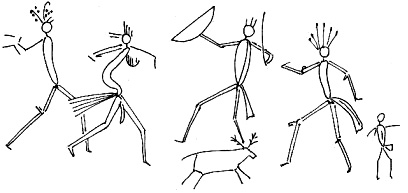This drawing of men engaged in hunting is by Dr. D. L. Kamat from a rock painting  at Bhimabetaka located 40 kilometers south of Bhopal, India. The paintings are between twenty to fifty thousand years old.
at Bhimabetaka located 40 kilometers south of Bhopal, India. The paintings are between twenty to fifty thousand years old.
Early humans scratched images of brave warriors hunting deer on cave walls to let others know what was going on in their lives. From books, to letters, to treaties, to published research findings, and public proclamations throughout the ages, our need to communicate about our individual and collective roles in the world has only increased as technology has made it easier for us to do that.
Skip thousands of years ahead to blogging across the Internet.
In a May 29, 2007 article by Cornelia Dean entitled, “Will Warming Lead to a Rise in Hurricanes?” The New York Times concluded with a recommendation from the secretary of homeland security, Michael Chertoff, “People living in vulnerable coastal areas should stockpile enough food and water to last at least 72 hours. “Your state and federal responders — they will not be there instantly when a hurricane arrives.”
Given our national experience with non-responsive emergency responders in the wake of Hurricane Katrina, this sort of advice logically answers the question posed in the headline and tends to get people talking about their individual concerns, as well as larger scientific issues related to Global Warming. Untangling the many strands of opinion and analysis from scientists on both political sides of the Global Warming debate has bloggers talking. This post by Sarah Burch from The Science Creative Quarterly , for example, http://www.scq.ubc.ca/ipcc-faq-part-deux-burch-mix-or-how-to-capture-the-climate-craze/, takes a stab at presenting Al Gore’s views alongside the Intergovernemental Panel on Climate Change’s Working Group
, for example, http://www.scq.ubc.ca/ipcc-faq-part-deux-burch-mix-or-how-to-capture-the-climate-craze/, takes a stab at presenting Al Gore’s views alongside the Intergovernemental Panel on Climate Change’s Working Group report .
report .
Why all the chatter? Because we will all be affected by policies that emerge from the debate about how much or how little global warming is influenced by human activity. Primitive humans let others know about how the hunting was in a particular area to ensure their mutual survival. Present-day humans talk about scientific issues and debate the merits of opposing points of view because our collective modern survival may depend on this type of significant conversation.
NSDL’s blogosphere is a place to talk about something interesting with topic experts, teachers and students. Add your voice to these ongoing conversations:
is a place to talk about something interesting with topic experts, teachers and students. Add your voice to these ongoing conversations:
NSDL News Topic Center: Current Science Information is a classroom tool for teachers to use in tracking and sharing day-to-day changes in news stories with students and other educators. Each week this blog provides succinct science, technology, engineering, and mathematics analysis and links to NSDL and other resources about a science story that’s in the news. Please add your comments to recent posts related to global warming issues:
is a classroom tool for teachers to use in tracking and sharing day-to-day changes in news stories with students and other educators. Each week this blog provides succinct science, technology, engineering, and mathematics analysis and links to NSDL and other resources about a science story that’s in the news. Please add your comments to recent posts related to global warming issues:
Southern Plant Species Bask in Northern Heat
Polar Bears Face Sudden Meltdown
How can digital education help the Gulf Coast? is a blog from “Katrina After the Storm: Civic Engagement Through Arts, Humanities and Technology,”
is a blog from “Katrina After the Storm: Civic Engagement Through Arts, Humanities and Technology,” a conference held one year after hurricanes devastated New Orleans and other Gulf Coast communities. Schools are open but struggling to replace libraries, equipment, and staff. Digital educators and others gathered to discuss the best ways to help. Please add your comments:
a conference held one year after hurricanes devastated New Orleans and other Gulf Coast communities. Schools are open but struggling to replace libraries, equipment, and staff. Digital educators and others gathered to discuss the best ways to help. Please add your comments:



Leave a Comment
* You can follow any responses to this entry through the RSS 2.0 feed.